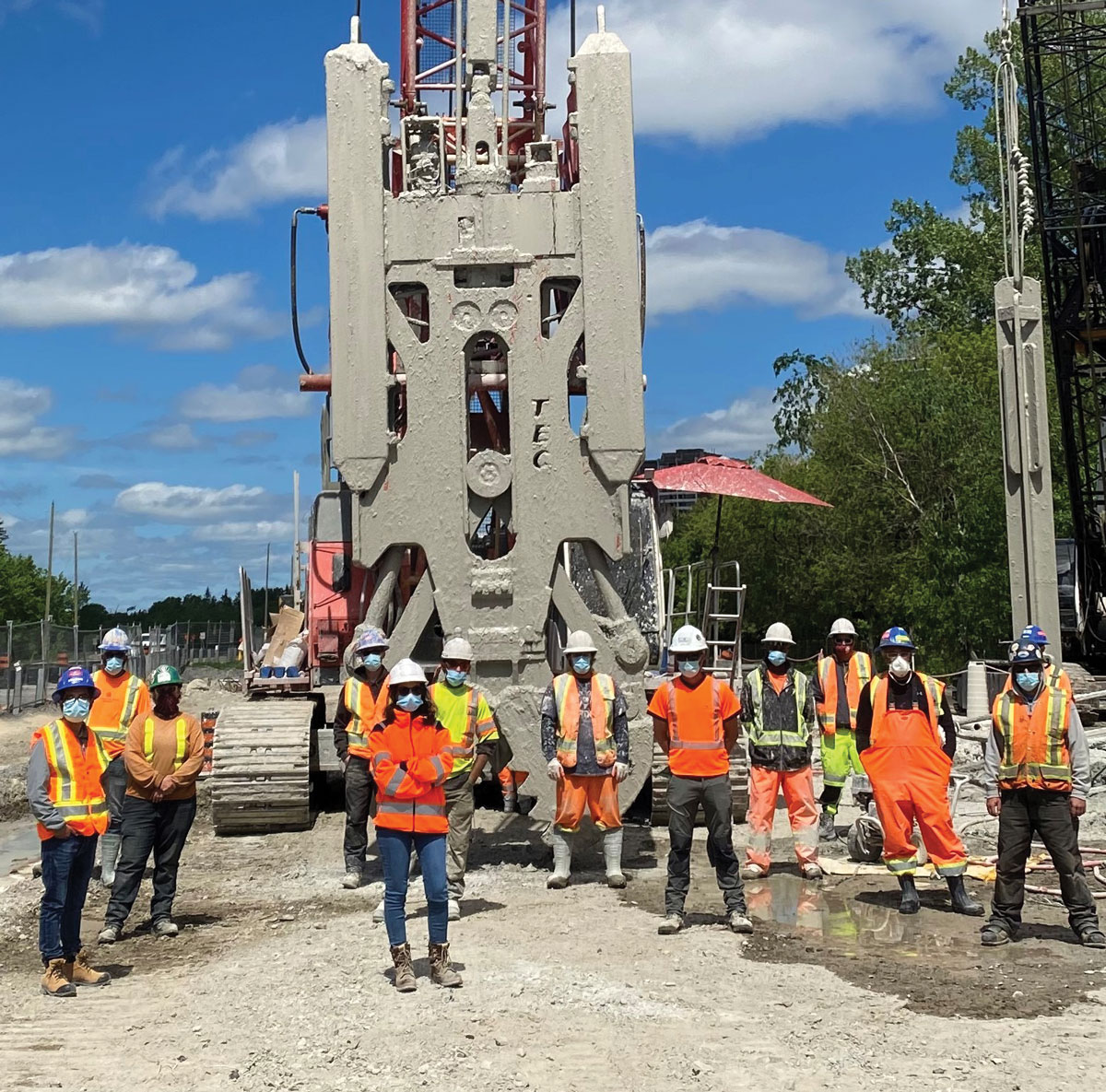
BuildForce Canada, an information hub that studies and forecasts long-term trends in the labour market, estimates that 257,100 construction workers will retire over the next decade. What’s more, they anticipate the industry will only hire 227,600 recruits, creating a gap of 29,500 job vacancies in Canada. For Luke Sheppard, construction equipment industry consultant and author of Driving Great Results, this means the construction industry will have to do a better job at recruitment.
“The purpose behind recruitment is to start long before there is a need to recruit people,” said Sheppard. “In many industries, recruitment is a large part of how they operate. But in the construction industry, in many cases, recruitment begins the day the need arises.”
According to Sheppard, a solid recruitment strategy goes hand-in-hand with proactive communication. It’s critical to build familiarity with the industry before the need to fill vacancies arises.

“We need to communicate to the general public what the construction industry is about,” said Sheppard. “When they see a piling machine operating on the side of the road, they should know that workers use it to drive piles into the soil, which creates the foundations for buildings.”
Sheppard also sees the need for the industry to address the less positive side of its narrative – acknowledging the history of racism and sexism in the workforce.
“We don’t tend to see the diversity of the general population in the United States and Canada reflected in the construction workforce,” he said.
“There are two steps to telling a better story: One – acknowledge the reality of the racism, sexism and hegemonic masculinity that still exists, and two – create the story it should be, starting with individual firms and companies making a point of highlighting inclusion and diversity in their literature.”
When the Canadian Construction Association (CCA) released its report on diversity in 2019, it found that women accounted for only 12 per cent of the construction workforce, while making up 47.7 per cent of the national workforce. What’s more, women’s share of on-site occupations – skilled trades like carpenters, bricklayers and boilermakers – only reached about four per cent.
Sheppard also sees the need for the industry to address the less positive side of its narrative – acknowledging the history of racism and sexism in the workforce.
“You’ve got to lift minorities up in this sector,” said Ruairi Spillane, managing director for OutPost Recruitment, an agency that specializes in construction and engineering recruitment.
“While the construction industry has done a lot to encourage outreach at schools and promote careers in construction to women, we still have to change the environment that doesn’t always see why a diverse workforce has insurmountable benefits,” he said.
Spillane also sees the potential for improving outreach to skilled newcomers arriving in Canada. When Spillane moved from Ireland to Canada, he began researching the looming labour shortage, discovering an opportunity to connect immigrants like himself with jobs in the construction industry, making the transition easy and more viable. He created an immigration help website called Moving2Canada, building a network that evolved into a recruitment agency.

“I wanted to identify talented newcomers early,” said Spillane.
Moving2Canada offers free resources to people coming to Canada, including information on visas, accommodation and studying. Although identifying talented newcomers started as a general call-to-action on the website, over time it began to focus primarily on the construction industry, turning the website into an invaluable hub to connect Canadian construction and engineering firms with quality international candidates.
In 2012, Moving2Canada and OutPost Recruitment, while still two different brands, became the same company. Spillane says the revenue model connects talent with employers, while the talent doesn’t have to pay any fees and matches up with a Canadian employer.
“The construction industry needed help,” said Spillane. “If you’re a headhunter, you’re taking a person from A to B, you’re not necessarily adding to the industry as a whole. At OutPost Recruitment, we take great pride in how we add candidates to the industry and bring in innovation from overseas.”
Although recruiting from outside of Canada is helping to address the labour shortage, when the borders closed in 2020 due to the Covid-19 pandemic, it stopped this critical flow of permanent and temporary workers from entering Canada to work in construction. Spillane estimates that Canada lost hundreds of thousands of newcomers over the last 15 months, intensifying an already pressing need for construction recruitment.
Spillane also sees the potential for improving outreach to skilled newcomers arriving in Canada.
“We’re working with a finite pool of candidates in this country,” Spillane said. “And we’re at a time where there’s an unprecedented demand for construction activity – so how do we increase the actual supply of workers across Canada?”
The Covid-19 pandemic also played a significant role in accelerating the labour shortage in Canada. One fascinating thing Spillane saw was how the pandemic transformed people’s work expectations. Many potential workers decided they wanted a better work-life balance – one without the risks associated with onboarding and working remotely.
“As a recruitment agency, we have a lot of opportunities,” he said, “but it’s difficult to find candidates to accept those roles.”

Sheppard agrees. “When you consider the kind of industry we’re in – we compete with restaurants and retail jobs because they can pay the same wages,” he said. “So, if someone has to choose between a job in a cozy warm environment versus piling in the field in cold and wet conditions … the choice becomes pretty easy.”
That’s why communicating the story behind construction becomes such a critical tool in a construction firm’s arsenal, says Sheppard. “Building our society through construction is a story that firms in the industry must tell,” he said.
One firm that avoided the overall labour shortage while proactively diversifying its workforce through immigration is Soletanche Bachy Canada, which provides innovative geotechnical solutions across North America.
Scott Kelly, vice president, corporate services at Soletanche Bachy Canada, attributes it to their global organization and framework. Their parent company, VINCI Construction, is based in France with over 1,000 sister companies in more than 110 countries worldwide.
The Covid-19 pandemic also played a significant role in accelerating the labour shortage in Canada.
Within Canada, says Kelly, the uncertainty surrounding the economy and Covid-19 has attributed to workers’ reluctance to move.
“However, we have lots of people around the world who are interested in moving to our country and transferring within our global organization to Soletanche Bachy Canada,” said Kelly. “We’ve been very successful in bringing people in from France, Turkey, and Columbia.”
Last October, Soletanche Bachy Canada brought over a young woman from France, originally from Algeria, to work in Ottawa. Kelly says Vinci Construction recognized early how male-dominated their industry was and aimed to address it by spending more time, effort and money on developing programs to engage girls in the fields of engineering, science and research.
Vinci has increased its percentage of female managers to 21 per cent, up from 15 per cent in 2018. Their global objective is to increase that to 28 per cent by 2023. Unfortunately, there are not yet enough candidates to meet the global demand. “More needs to be done in the short-term to attract women to this industry,” Kelly said.

Soletanche Bachy Canada has worked with OutPost Recruitment, receiving one resumé, which according to Kelly, was excellent. “The individual wanted to hold off and we respect that. I would rather have a targeted, smaller number of quality resumés than getting dumped on by a variety of unskilled resumés from an Indeed ad.”
In addition to the 29,500-worker gap resulting from the shortage of workers to take the place of retirees, CCA expects a four per cent increase in labour demands – which means the industry will need to attract more than 80,000 more recruits. “We’re going to see a lot more demand for infrastructure and construction activities, and therefore, even more increased demand for recruiting,” said Sheppard.
An employee referral plan is one way to build a diverse workforce strategically and an under-used efficiency in the construction industry. “Other industries have done it more successfully because the program is simple and management pays the individual right away if they hire the candidate,” he said.
“You can drive diversity with these programs,” said Sheppard. Moreover, a referral program takes advantage of the simplest and easiest way to tell the story of construction: through the people who work within the industry. “Sometimes, referral programs can be a homogenous process,” he said. “But if you explicitly state what you want and the story you want to tell, you can build a better workforce within your company.” ![]()